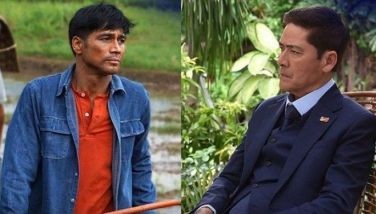The last time I saw Joey
MANILA, Philippines - The last time I saw Joey Velasco was the first time. We’ve been friends in the true sense of the word even if we never met... only texting and calling each other even if we lived barely a mile within each other in Fairview, Quezon City... until Tuesday last week when, under a soporific drizzle, I decided to pay him a surprise visit and hand him a basketful of fruits.Part of his sala was converted into a hospital-like space. Beside Joey’s bed was an oxygen tank and a dialysis machine which Joey himself would operate thrice a week. His two kidneys were gone; his kidney cancer was in its last, critical stage.
“He could go anytime,” Kim Atienza texted me two days earlier. Kim and Joey were classmates in the seminary. His tight TV schedule notwithstanding, Kim would visit Joey every day, rain or shine.
My “drop-by” visit lasted for more than 30 minutes. Joey and I talked about things spiritual and how, like him and Kim, I almost entered the seminary after the elementary graduation hadn’t Fr.Fernando Tan, our parish priest in Las Navas, Northern Samar, drowned in a freak accident when he fell from his outboard motorboat while navigating the long stretch of the Catubig River one lazy afternoon on his way back to Las Navas.
Before we parted, Joey’s wife Queenie invited me to their 15th wedding anniversary at their home, supposedly last night, and I assured them that I would take a day off just to be there.
At dawn last Tuesday, July 20, Joey slipped gently into the night, not “raging against the dying of light” since he had long been resigned to his fate. Queenie and the couple’s four children, together other loved ones, surrounded Joey’s deathbed to bid him a quiet farewell. He was 43.
As a send-off to Joey (whose remains lie at the Funeraria Nacional on Araneta Avenue; interment is scheduled tomorrow, July 24, at the Loyola Memorial Park in Marikina City after the 10 a.m. Mass), I am reprinting a story I wrote in November 2007, titled The Story behind Hapag ng Pag-asa:
It turned out that I was among the last to know.
By the time my friend Raoul Tidalgo and I saw Hapag ng Pag-asa hanging on a wall at the souvenir store of the Sto. Nino Shrine in Cebu City last summer, we would learn that priests had been extolling it in their sermons and several people had hung framed copies of it in their dining rooms, the better to remind every member of the family — and house guests as well — not to leave a crumb on the plate because out there, without their knowing it, or beyond the fence of every well-provided-for home, are hungry souls with not a bite to eat.
Done in oil on a 48x96 canvas by an artist named Joey Velasco, Hapag ng Pag-asa is a variation — I should say, a very relevant, modern-day version — of The Last Supper, with street children in dirty clothes sharing a meal with Jesus, instead of the usual 12 apostles we’ve all been accustomed to seeing. At the extreme left of the wooden, makeshift table sits a boy looking away from Jesus, holding a bag he must have snatched from somebody, instead of Judas clutching a bag with 30 pieces of silver.
Moved by the sad and empty faces of the children in the painting, with our conscience pricked, Raoul and I watched Hapag ng Pag-asa nearly teary-eyed with mounting curiosity, noting how Jesus appears so comfortable and so at-home with his table-mates, engrossed in breaking what looks like a pizza pie.
There and then, I bought 10 pieces of the painting and, as soon as I got back to Manila, had them framed, hung one at the office and gave the rest away to members of my family and dear friends, among them Ethel Ramos and Ronald Constantino who would tell me that for several days, the painting seemed to haunt him. “I felt a bit depressed and I couldn’t eat,” said Ronald who found something “disquieting” in what the artist Velasco called Table of Hope.
The one who touched me the most is the little boy bent over under the table, sharing what could be crumbs with a (presumably stray) cat, looking so emaciated and no better than a rat devouring a piece of stolen cheese.
I wondered, who could these children be? Did artist Velasco paint them from imagination? Are they fictitious faces plucked from random memory and gathered like a one-for-all/all-for-one barkada? Or are these children real, moving in our midst, roaming the streets with nowhere to go, no warm beds to lay their weary bodies in?
One day, The STAR’s night editor Patricia Esteves gave me a copy of a book called They Have Jesus (The Stories of the Children of Hapag) which finally solved the “mystery.”
“Joey (Velasco) asked me to give it to you,” she said. “Joey said that you two met in Hong Kong a few years back.”
I didn’t recall meeting Joey but I remember every story of the 12 boys in the painting long after I read the book in one sitting.
The children are real after all, all 12 of them. One is dead and the rest are alive but not too well, living in cramped spaces under the bridge which they call “home,” scavenging the trash in Payatas, snatching a bag from a rich-looking passerby, selling sampaguita while dripping wet in the rain, knocking on car windows for some coins, molested at the tender age of 13 by a drug-addicted neighbor, maltreated by jobless parents. Jesus, I’m sure, is in every one of those children whom Joey calls by fictitious names in the book. You see, even the down-trodden have a privacy to protect.
Joey found what I want to describe as “children of a lesser god” (title of a Hollywood movie) in depressed places in Metro Manila, including a cemetery, photographed them and then painted them into what passes for a foster family, sharing a measly meal.
The famished little boy under the table was inspired by “The Unknown Sudan Boy,” whose photo taken in the 1994 Sudan famine won for the photographer, Kevin Carter, a Pulitzer Prize. Wrote Joey: The picture shows a heart-breaking scene of a starving child who collapsed on the ground, struggling to get to a food center in Sudan, Africa, in 1993. In the background, a vulture stalks the emaciated child. The vulture is waiting for the child to die so that it can eat the tiny human being. No one knows what happened to the child, not even the photographer himself.
Three months later, recounted Joey, Carter was found dead of carbon-monoxide poisoning in Johannesburg, a suicide at 33, so depressed and “haunted by the vivid memories of killings and corpses; anger and pain...of starving or wounded children...”
When the painting was done, Joey revisited each and every member of the Hapag ng Pa-asa, showed them the painting and asked them to identify themselves and, again, like he did the first time he saw them, treated them to a Jollibee meal and plateful of hot noodles. A feast, no doubt, for the kids who were lucky to get by with one good meal (rice and dried fish) a day.
His ardent wish, according to Joey, is to one day see the Hapag ng Pag-asa turned into a Hapag ng Pagibig, with the sad faces of Jesus’ modern-day “apostles” wearing a happy smile.
- Latest
- Trending

































